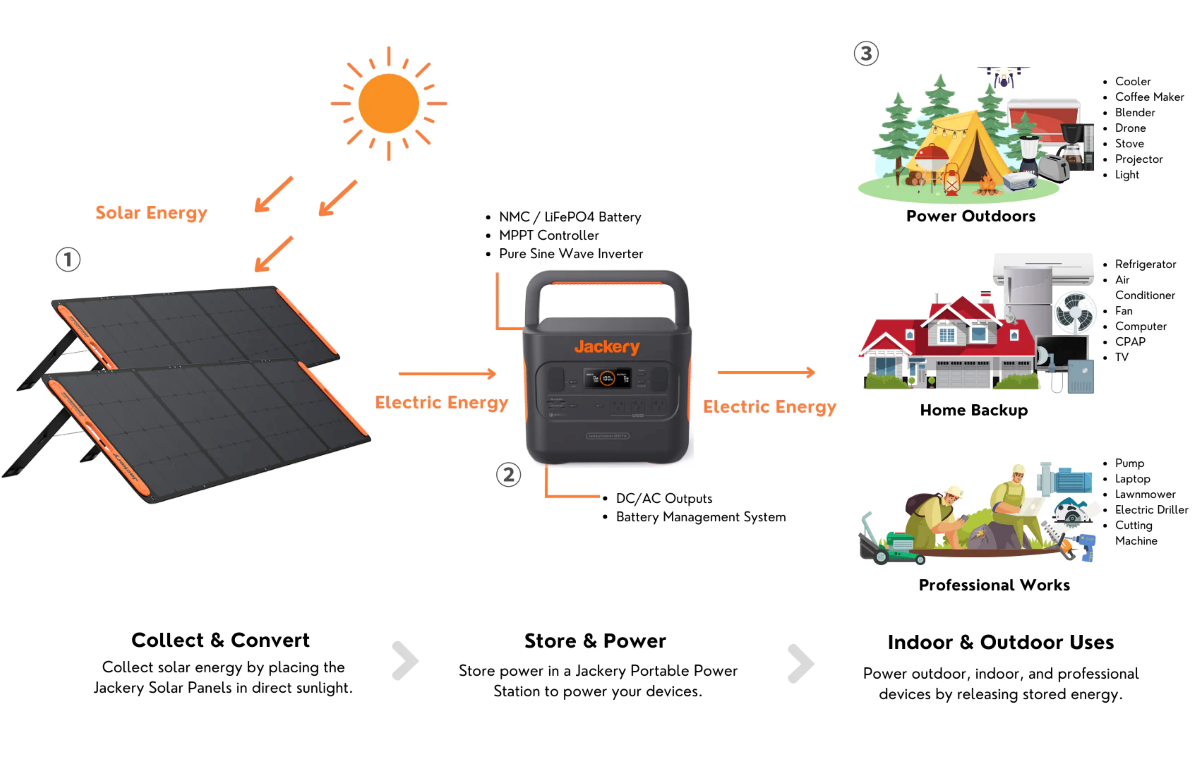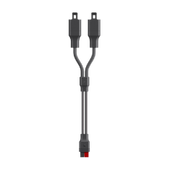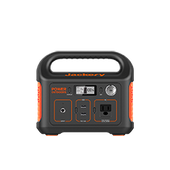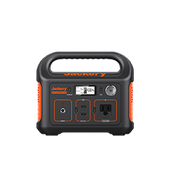RV batteries can be charged in many ways, including generators, solar power, tow trucks, and wind power. To avoid battery degradation over time, it is essential to charge an RV battery before it depletes to less than 50%. To understand how to charge RV batteries, it is necessary to know the basics of the different types of batteries available.
Although there are various methods to charge RV batteries, solar power can be one of the most beneficial, considering cost efficiency, sustainability, eco-friendliness, and reliability. Solar generators like the Jackery Solar Generators offer renewable energy to power your recreational vehicle’s battery and protect it in the long run.
Key Takeaways
- Generally, you need a 200 to 400-watt solar panel setup to charge your RV battery.
- There are four types of RV batteries, including lithium-ion, absorbent glass mat (AGM), LiFePO4, and lead-acid.
- RV battery charging time can range from ten to forty hours, depending on the power source you use,
- Six primary ways to charge RV batteries include solar power, shore power, vehicle alternator, generator, tow vehicle, and wind power.
Understanding RV Batteries
RV stands for recreational vehicle, and an RV battery is the power source for all RV electrical systems. RV batteries are of two types: starting or chassis and house batteries. Starting batteries start an RV engine, power lights, and other electrical systems. Although RV batteries are similar to car batteries, they provide a steady flow of power for a long time. When the RV is not connected to shore power, house or deep-cycle batteries power the appliances when connected in parallel.
A house battery mainly runs devices such as an RV fridge, TV, hob, etc. It uses an internal plate to provide electricity for an extended period. When the alternator is not running, the starter battery works to start the engine as it is designed to use large currents. A dual battery system is a vehicle with a house and chassis battery.
Most batteries can be damaged if left discharged after 50% consumption. This can cut the battery life and reduce its efficiency. So charging batteries after they have been discharged to 50% can extend their lifespan. You can charge a LiFePO4 battery when it reaches 80% depletion.
The time it takes a battery to recharge depends upon its type, the depletion percentage, the charger, and the power source. Old batteries take as much as five times more to charge than new batteries. To calculate the exact charging time, you can divide the ampere-hours by the ampere of the power source.
What Are The Types of RV Batteries?
An RV battery is a power source for all the electrical appliances in an RV, and depending on your needs, it is essential to have a long-lasting and reliable power source for your recreational vehicle. There are mainly four types of RV batteries:
Lithium-ion
Lithium-ion batteries,also known as Li-ion batteries, are advanced battery technology. As lithium ions move, an electrical current is generated. Li-ion batteries have a longer lifespan, long-term performance, and fast charging time. They are also lightweight and temperature-resistant.
Pros
Lithium-ion batteries can deliver up to five times more power than lead-acid batteries. They have a compact design and demonstrate high energy density. With around 2000 charge-discharge cycles, they have a lifespan of 8-10 years. Lithium-ion batteries are resistant to hazards and explosions.
Cons
Lithium-ion batteries use rare metals, increasing the refining process's cost; hence, they can be relatively expensive. Lithium-ion battery repair can be challenging due to international safety standards.
Capacity
The amount of electric charge stored and delivered by the battery is called its capacity. Lithium-ion battery capacity is specified in ampere-hours (Ah) or mAh. For example, if each battery needs to deliver 2000mA of current, a battery with 4000mAh capacity can deliver 4000mA current for one hour.
Lead-acid
Lead-acid batteries have long been used in the RV industry due to their reliability and affordability. One type includes flooded lead-acid batteries. In these batteries, lead plates are dipped in electrolyte solution. This demands regular maintenance to check the water level whenever required. These batteries have low upfront costs, have high rating self-discharge, and are maintained using a battery charger.
Pros
Lead-acid batteries do not require maintenance and are available in all shapes and sizes. They can also withstand slow and fast charging and long-term inactivity in the presence or absence of solvent. They can be recycled and reused in new batteries and have the most extended lifecycle.
Cons
Not only is lead heavier than other elements, but it also has a low weight-to-energy ratio. A full charge takes around 14-16 hours.
Capacity
A lead-acid battery's high mAh rating denotes a higher capacity. For example, a battery with a capacity of over 2000mAh can be used for 12V applications.
LiFePO4
Lithium iron phosphate batteries are an advanced innovation in the RV industry. They are lightweight and have extended longevity. RV batteries can handle deep discharge cycles and high charge-discharge rates efficiently. However, lithium iron phosphate RV batteries are more expensive than their lithium counterparts and require specialized charging devices.
Pros
LiFePO4 batteries have a chemical structure that is less combustion-prone and can be considered a safer choice for appliances. They are ideal for RVs and applications that require frequent cycling as they can endure many charge-discharge cycles. Moreover, they have a high power density, deliver high power output, and operate in a wide temperature range.
Cons
LiFePO4 has a lower energy density than other lithium-ion chemistries, meaning the capacity to store energy per unit volume is lower. LiFePO4 batteries use high-quality materials and manufacturing processes, which makes them more expensive. The limited availability of lithium iron phosphate batteries can affect the market's ease of sourcing and availability range.
Capacity
LiFePO4 batteries have a larger capacity between 5Ah and 1000Ah. Compared to 300 times the life cycle of lead-acid batteries, a lithium iron phosphate battery has a life cycle of over 2000 times and can last for 7-8 years.
AGM
Absorbent glass mats or AGM batteries are known for their maintenance-free functionality and versatile operation. These batteries use a fiberglass mat separator that absorbs the electrolyte solution and mounts the batteries in various positions. AGM batteries have deep cycling capabilities and can power RVs during off-grid adventures.
Pros
AGM batteries are spill-proof, as they have fiberglass mats. They are vibration and shock-resistant, which means they can withstand the vibration of military airplanes. Though they might not operate in freezing temperatures, they can withstand colder temperatures and are not damaged.
Cons
These cannot withstand high voltage and overcharging and are unsuitable for some appliances. AGM batteries require a charger to monitor volts, amperes, and surrounding temperatures.
Capacity
AGM batteries range from 30 to 100Ah and are used in UPS for deep cycle use. In RVs, they power heated seats, windshields, steering wheels, and other items. When discharged in one hour, an AGM battery provides only 60% of its rated capacity.
Lithium batteries are lightweight and compact, so they can pack more energy, giving more power to your RVs. By using a lithium battery, you can cut down on some weight and travel feeling more relaxed. Lithium batteries can charge up faster than other batteries and give you a steady output throughout their cycle.
Step by Step to Charge RV Batteries
Charging your RV batteries correctly is crucial; if you are a starter, you must learn how to charge them to get power. Careful charging can extend your battery life cycle, and here are some basic steps to charge your RV battery:
Step 1: Turn your RV off and set the emergency brake to prevent injury. Then, locate your RV battery, as depending on the size and model, you may have more than one battery.
Step 2: Once you can locate the battery, remove the cables from the battery using a wrench. First, remove the negative side (black cable) and then the positive side (red cable).
Step 3: Clean the battery connection from any corrosive substance using baking soda paste. Apply the paste to the connections and scrub off the caustic material. To avoid further corrosion, you can apply petroleum jelly.
Step 4: Check the battery fill cap to see if the water level is low. If it is, pour distilled water into the tank using a funnel.
Step 5: To attach the battery charger to the battery, first connect the positive side to the red cable and the negative side to the black cable. Then, plug in the charger and turn it on.
Step 6: Let the RV battery charge completely. Once the charging finishes, the indicator light will illuminate.
Step 7: After unplugging the charger, remove all the connections, then reconnect the battery using the red and black/blue cables.
For more detailed guidance, you can also refer to the following resources.
Different Methods to Charge RV Batteries
Learning the ins and outs of an RV battery before charging it is essential, as each type has a different requirement and specification. Different batteries require different charging methods, and there are mainly six ways to charge an RV battery without a charger:
Shore power
It is one of the easiest and most common ways to charge RV batteries. It uses the vehicle’s electrical system and built-in converter charger to charge the batteries. Once you plug in your RV, the electricity will flow to the built-in converter, and the DC battery charger converts it from AC into DC. Once the batteries are charged, the DC electricity is returned to the inverter and converted into usable AC power. This alternating current can power appliances, lights, and outlets.
Pros
Shore power helps reduce emissions into the environment. For example, cruise ships can reduce CO2 emissions by 66% with the help of shore power. Another benefit of shore power is a reduction in engine wear and tear.
Generator
Generators are typically inexpensive and can be used anywhere, including RV parks. However, many camps and RV grounds have banned them since they have high noise levels. Solar generators, which are noiseless and non-toxic for your RV, can be a safe alternative.
Pros
Generators can supply uninterrupted power even when there is a problem with the electrical network. Generators can also avoid damages caused by a sudden blackout.
Alternator
You can charge your RV house batteries while your towing vehicle engine is running. The alternator converts mechanical energy into storage energy, leaving a convenient option. But this is also the slowest charging method, and you may need to spend a lot of time on the road. The alternators use a set of rotating coils called rotors, which are turned by the pulley. The rotor shaft spins a set of magnets inside the coil, generating AC in the stator. The AC is then converted to DC by the rectifier, which activates the vehicle’s electrical system.
Pros
An alternator can charge your RV’s battery so it functions properly. This also reduces the strain on the battery when the RV electrical system is in use. Alternators do not experience fluctuations and can provide a steady stream of electrical energy.
Solar power: Solar Panel System, Portable System
A solar power system provides the cleanest and greenest method for charging RV batteries. Solar generators like the Jackery Solar Generator combine solar panels and portable power stations, which can harness power from the sun and convert it into storable battery power. The solar panels trap sun energy during the day and convert it into electrical energy. The built-in inverter in the power station converts DC into AC and supplies power to RV appliances.
Pros
Solar power systems use renewable energy sources and save money on non-rechargeable batteries. They also save electricity and its related costs. Solar power is readily available and can provide a power supply even in remote locations.
Tow Vehicle 12V Feed
These types of RVs apply to travel trailers and have trailer wiring connections. These wiring connections ensure that lights and turn signals are operated in trailers and tow vehicles. When the outlet and trailer cord are wired correctly, they provide a 12-volt power feed from the tow truck alternator and send power back to the RV.
Pros
Tow vehicle charging can save money on energy use by setting up your vehicle to charge during off-peak hours. This type of power supply serves as a mobile power source, and you can use it to power your appliances while camping.
Wind Power
A wind turbine system can convert wind energy into electrical energy and provide an off-grid charging solution for your RV. Upfront costs and reliance on wind can be challenging, but it can be feasible with ample wind. When the wind turns the propeller, like blades around a rotor, it spins a generator, creating energy.
Pros
Wind energy can benefit local communities, has low operating costs after installation, and provides clean energy.
A solar power supply like the Jackery Solar Generator is easily operable and saves time while charging your RV. It is affordable with a simple set-up and operates silently under 30dB. It provides solar power with zero emissions and can keep your family and friends powered during operations.
Jackery Solar Generators for RV Batteries
Jackery is a global manufacturer of solar generators, portable power stations, and solar panels, inspiring every nature-lover to sustainably explore and seek outdoor adventures. Jackery Solar Generators are sustainable power solutions combining Jackery Portable Power Station and Jackery SolarSaga Solar Panels.

When placed in direct sunlight, solar panels trap sunlight and transform it into electrical energy. This energy is stored in a battery power station, and the built-in inverter converts DC into AC to supply power to RVs and related appliances. The Jackery Solar Generator features quick solar charging and is lightweight to carry around easily. It is durable, long-lasting, and can work efficiently on humid days.
Jackery Solar Generators are portable charging solutions providing a supplementary RV battery power supply. While they have limited capacity compared to RV batteries, you can charge most RV appliances with powerful Jackery Solar Generators.
Jackery Solar Generator 3000 Pro
The Jackery Solar Generator 3000 Pro is an ideal power supply for appliances during RV trips, camping, or home emergencies. It has a large capacity to power your essential devices while you enjoy your RV life. It has a portable design with pull rods and double wheels and can be dragged around easily.
Appliance Working Hours
- Laptop (70W): 36.7H
- Portable Induction Cooker (900W): 2.8H
- RV AC (640W): 4.0H
- Heater (1200W): 2.1H
- Microwave (1500W): 1.7H

Customer Review
"We purchased the 1000 last summer for a 6-week western US road trip and were completely satisfied. It is easy to set up, transport, and charge when stopped or driving. It powered our portable fridge/freezer, allowing us to meal prep the first three weeks of the trip. " -- James
Jackery Solar Generator 2000 Plus
The Jackery Solar Generator 2000 Plus delivers an expandable capacity and is ideal for off-grid or RV living. With this solar energy, you can enjoy full and independent power with long-lasting reliability. It also has a foldable handle and suitcase-style design, so you can move the powerful solar generator to any RV park and enjoy your trip.
Appliance Working Hours
- Laptop (70W): 24.8H
- Portable Induction Cooker (900W): 1.9H
- RV AC (640W): 2.7H
- Heater (1200W): 1.4H
- Microwave (1500W): 1.1H

Customer Review
“I purchased this for my camping needs when power is unavailable at campsites for use with my Class A, Pop-up, and truck camping. In conjunction while running appliances on propane, the 2000 Plus powered me through the night with heat and general lighting with power to spare the following morning.” -- Chris K
Jackery Solar Generator 2000 Plus Kit (4kWh)
Adding a battery pack and solar panels, the Jackery Solar Generator 2000 Plus Kit (4kWh) is perfect for road trips, camping, and home emergencies. It can charge your RV appliances whenever needed and ensure you are not out of power.
Appliance Working Hours
- Laptop (70W): 49.6H
- Portable Induction Cooker (900W): 3.8H
- RV AC (640W): 5.4H
- Heater (1200W): 2.9H
- Microwave (1500W): 2.3H

Customer Review
“I’ll be using this unit in our 22’ RV (30 amp) and living off the grid in our larger 5th wheel in the summer months. I’m impressed with the quality and design (even the packaging) of the Jackery products and am looking forward to replacing a gas-guzzling generator(s).” --Randall MacPherson
Safety Tips for Charging RV Batteries
No matter which charging method you prefer to charge your RV battery, you should know how to stay safe with these charging batteries. Here are some safety tips and tricks you should keep in mind while charging RV batteries:
Tip 1: If you use lead-acid batteries, clean the terminals regularly to avoid sulfation and rust interference with the charge. Use the correct type of charger for the battery type you use.
Tip 2: If you use solar panels, you should have a battery charge controller. Stay updated with a smart battery charger that can function through your phone.
Tip 3: If you store your RV, hook it up to a trickle charger. Avoid charging batteries if the temperature is higher than 122 degrees.
Tip 4: Check your battery for dirt, oil, or water and clean it up, as this may lead to discharging the chemicals, causing a short circuit. Park your RV on a level road whenever you are about to charge it, and do not forget to put the parking brakes on.
Tip 5: A lithium-ion charger will indicate the battery is ultimately charged when the charger's light is on.
Tip 6: Keep your lead-acid batteries in a ventilated place and clean them before charging. Always use a charger compatible with your battery type and avoid charging a frozen battery.
How to Charge RV Batteries FAQs
What size of solar generator do I need for my RV batteries?
By investing in solar generators, you can access clean and renewable energy. However, to determine the exact size of the solar generator for your RV batteries, you should know the number of batteries you want to charge and for how long.
For example, a Jackery Solar Generator 3000 Pro can charge a lead-acid battery (1500W) and an AGM battery (1000W),
Working Time = Capacity in Wh × 0.85 / Operating wattage of the appliances.
So, Working time = 3024Wh × 0.85 / 2500W = 1.0H
Note: While charging the devices, some power loss occurs; hence, multiplied by 0.85.
How do RV batteries get charged?
RV batteries can be charged using generators, shore power, alternators, or solar power supply.
How long does it take an RV battery to charge when dead?
To calculate the number of hours it will take to charge the battery after it is dead, you can divide the rated ampere hours (Ah) by the ampere of your solar panels, charger, or AC plug.
Should I disconnect my RV battery when plugged in?
For long-term storage, it is recommended to disconnect the RV batteries when plugged in.
What is the life expectancy of an RV battery?
The most common types of RV batteries can last from three to seven years.
Charging RV Batteries
Correctly charging RV batteries is essential to sustain them without any fluctuations. This will not only ensure countless rounds of camping but will also make sure you have power whenever you want it. Before you understand how to charge RV batteries, you must be aware of the various types of batteries and the ways to charge them. With solar power being one of the most economical ways, Jackery Solar Generators provides an independent and renewable power source for your RV batteries. With its sustainable next-generation generators, Jackery stands firm in bringing green energy to all adventure lovers.





































































































































































![How to Charge RV Batteries [Ultimate Guide 2024]](http://www.jackery.com/cdn/shop/articles/how_to_charge_rv_batteries.jpg?v=1717379773)







Leave a comment